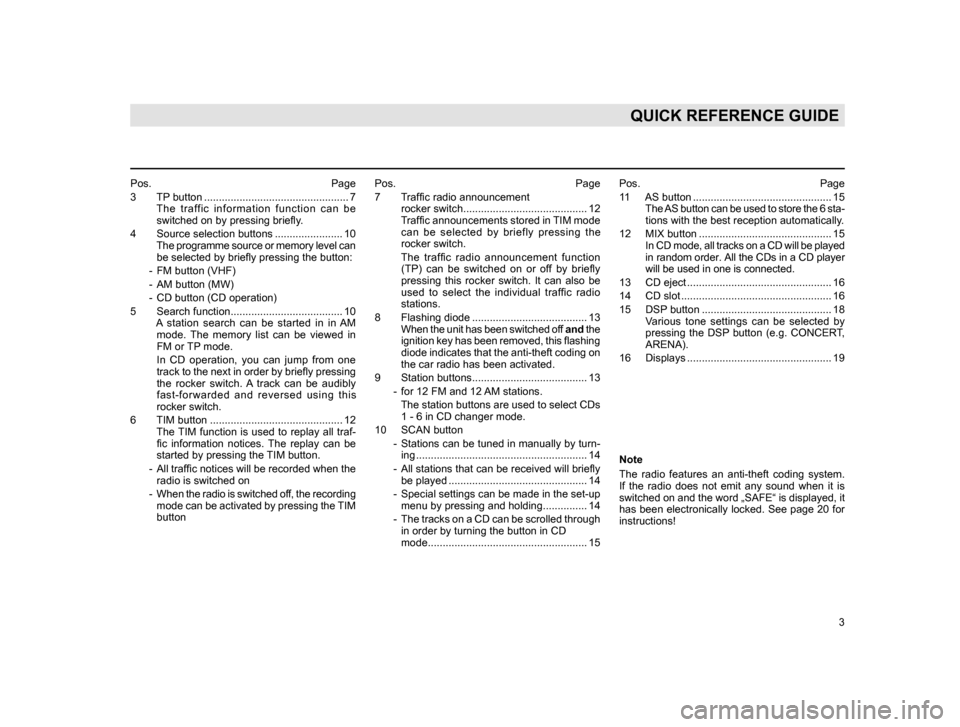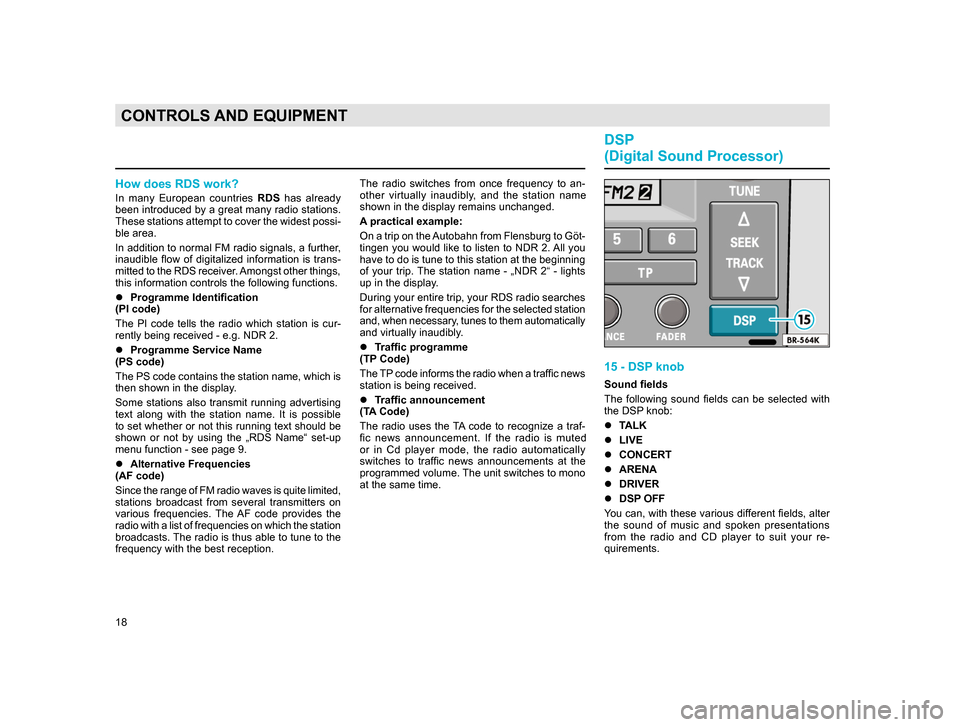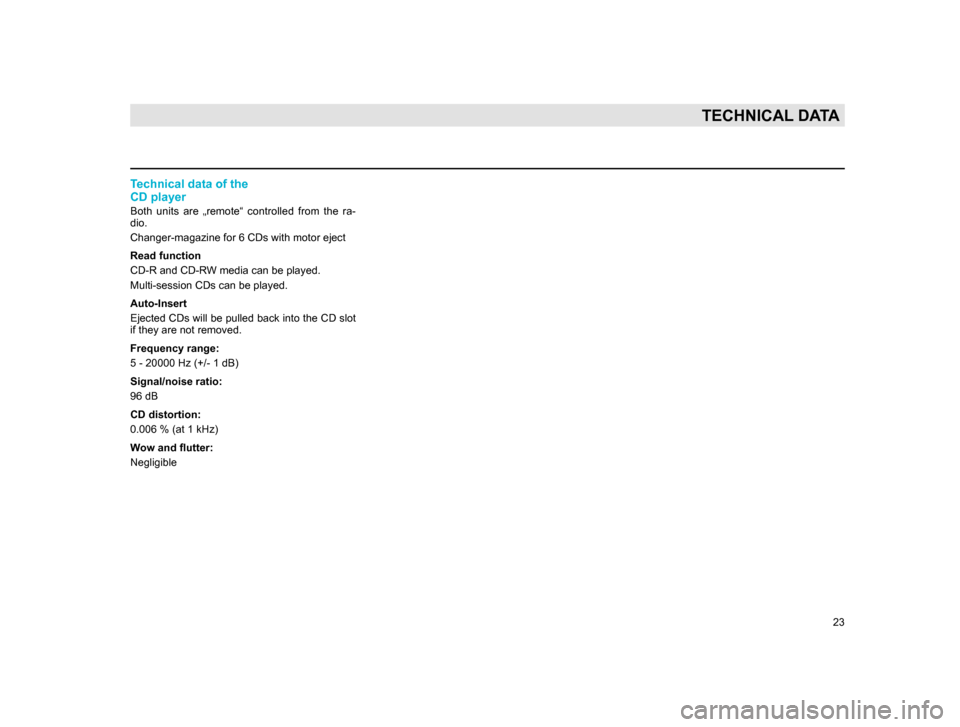CD player SKODA SUPERB 2005 1.G / (B5/3U) Rhapsody Car Radio Manual
[x] Cancel search | Manufacturer: SKODA, Model Year: 2005, Model line: SUPERB, Model: SKODA SUPERB 2005 1.G / (B5/3U)Pages: 27, PDF Size: 1.37 MB
Page 4 of 27

3
QUICK REFERENCE GUIDE
Pos. Page
3 TP
button ................................................. 7
The traffic information function can be switched on by pressing briefly.
4 Source selection buttons ....................... 10
T
he programme source or memory level can be selected by briefly pressing the button:
- FM button (VHF)
- AM button (MW)
- CD button (CD operation)
5 Search function...................................... 10
A
station search can be started in in AM mode. The memory list can be viewed in
FM or TP mode.
I
n CD operation, you can jump from one track to the next in order by briefly pressing
the rocker switch. A track can be audibly
fast-forwarded and reversed using this
rocker switch.
6 TIM button ............................................. 12
The
TIM function is used to replay all traf- fic
information notices. The replay can be
started by pressing the TIM button.
- All
traffic notices will be recorded when the radio is switched on
- W
hen the radio is switched off, the recording mode can be activated by pressing the TIM
button Pos. Page
7 T
raffic radio announcement
rocker switch.......................................... 12
T
raffic announcements stored in TIM mode can be selected by briefly pressing the
rocker switch.
T
he traffic radio announcement function (TP) can be switched on or off by briefly
pressing this rocker switch. It can also be
used to select the individual traffic radio
stations.
8 Flashing diode ....................................... 13
W
hen the unit has been switched off and the
ignition key has been removed, this flashing
diode indicates that the anti-theft coding on
the car radio has been activated.
9 Station buttons....................................... 13
- for 12 FM and 12
AM stations.
The
station buttons are used to select CDs 1 - 6 in CD changer mode.
10 SCAN button
- Stations
can be tuned in manually by turn- ing .......................................................... 14
- All
stations that can be received will briefly be played ............................................... 14
- Special
settings can be made in the set-up menu by pressing and holding............... 14
- The
tracks on a CD can be scrolled through in order by turning the button in CD
mode...................................................... 15 Pos. Page
1
1 AS button ............................................... 15
T
he AS button can be used to store the 6 sta- tions with the best reception automatically
.
12 MIX button ............................................. 15
I
n CD mode, all tracks on a CD will be played in random order. All the CDs in a CD player
will be used in one is connected.
13 CD eject ................................................. 16
14 CD slot ................................................... 16
15 DSP
button ............................................ 18
Various tone settings can be selected by pressing the DSP button (e.g. CONCERT,
ARENA).
16 Displays ................................................. 19
Note
The
radio features an anti-theft coding system.
If the radio does not emit any sound when it is
switched on and the word „SAFE“ is displayed, it
has been electronically locked. See page 20 for
instructions!
20.indd 27.6.2003, 14:32
3
Page 11 of 27

10
CONTROLS AND EQUIPMENT
4 - Source selection buttons
Radio operation
FM button
The VHF wavelength can be selected by pressing
the FM button.
The first memory level of the VHF wavelength can
be reached by pressing the FM button once.
The second level can be reached by pressing
the button again.
„FM1“ appears in the display for the first memory
level or „FM2“ for the second - see page 19.AM button
The MW wavelength can be selected by pressing
the AM button.
The first memory level of the AM wavelengths can
be reached by pressing the AM button once.
The second level can be reached by pressing
the button again.
„AM1“ appears the first memory level or „AM2“
for the second - see page 19.
CD operation
CD button
The CD mode of the internal CD player is selected
by pressing this button.
„NO CD“ will appear in the display if no CD is in
the player.
If a CD changer has been installed it is possible to
switch between the CD player and the CD changer
by pressing the CD button.
The operation of the CD changer is described in
a separate instruction manual.
Note
If the connection to a connected CD changer has
been interrupted, „NO CHANGER“ will appear in
the display if you wish to switch between the CD
player and the CD changer.
5 - Manual setting
Radio operation
Search
Only
on AM wavelength!
Briefly press the search rocker switch on the up-
per or lower part - the search will be started in the
direction as selected and the radio will select the
first station with a strong signal and then stay at
that frequency.
Memory list
Only on FM wavelength!
Your radio is constantly orientating itself to the
station frequencies. After switching on, it auto-
matically stores all RDS stations (see information
as of page 17) in a memory list according to their
PI code (Programme Identification).
20.indd 27.6.2003, 14:32
10
Page 17 of 27

16
CONTROLS AND EQUIPMENT
13 - CD eject
The Cd will be ejected from the CD player when
the CD eject button is pressed.
l„CD EJECT“ appears in the display.
Note
The
CD will automatically be pulled back into the
player if it is not removed from the slot within ap-
proximately 10 seconds.
14 - CD slot
Push the CD with the printed side facing up
into the CD slot until it is pulled in automatically.
The tracks on the CD will be played.
CD mode and traffic news
If TP mode is switched on before the CD button 4
is pressed, CD playback is interrupted for traffic
news announcements.
If the transmitting range of the station is left, the
radio automatically selects a new traffic news
station.
A traffic announcement being made can be in-
terrupted by pressing the TP button 3 and the
CD player will resume its function.
The interrupted announcement will still be re-
corded and can be played at a later point.
Any subsequent traffic news announcement will
still be played.
To enjoy listening to your CD without interruption,
press and hold the Tp button 3 until „TP: OFF“
appears in the display.
Fault indicators
The following fault messages can appear in the
display:
- „NO MAGAZINE“
No magazine in the CD changer
.
- „NO DISC“
No CD in the CD player
- „NO CD“
The
chosen compartment in the magazine of the
CD changer is empty.
- „CD ERROR“
T
he CD in the chosen compartment has been
inserted with the printed side down or the CD is
heavily soiled or damaged.
20.indd 27.6.2003, 14:32
16
Page 19 of 27

18
CONTROLS AND EQUIPMENT
How does RDS work?
In many European countries RDS has already
been introduced by a great many radio stations.
These stations attempt to cover the widest possi-
ble area.
In addition to normal FM radio signals, a further,
inaudible flow of digitalized information is trans-
mitted to the RDS receiver. Amongst other things,
this information controls the following functions.
l Programme Identification
(PI code)
The
PI code tells the radio which station is cur-
rently being received - e.g. NDR 2.
l Programme Service Name
(PS code)
The
PS code contains the station name, which is
then shown in the display.
Some stations also transmit running advertising
text along with the station name. It is possible
to set whether or not this running text should be
shown or not by using the „RDS Name“ set-up
menu function - see page 9.
l Alternative Frequencies
(AF code)
S
ince the range of FM radio waves is quite limited,
stations broadcast from several transmitters on
various frequencies. The AF code provides the
radio with a list of frequencies on which the station
broadcasts. The radio is thus able to tune to the
frequency with the best reception. The radio switches from once frequency to an-
other virtually inaudibly, and the station name
shown in the display remains unchanged.
A practical example:
On a trip on the Autobahn from Flensburg to Göt-
tingen you would like to listen to NDR 2. All you
have to do is tune to this station at the beginning
of your trip. The station name - „NDR 2“ - lights
up in the display.
During your entire trip, your RDS radio searches
for alternative frequencies for the selected station
and, when necessary, tunes to them automatically
and virtually inaudibly.
l
Traffic programme
(TP
Code)
The TP code informs the radio when a traffic news
station is being received.
l T
raffic announcement
(TA Code)
The radio uses the TA code to recognize a traf-
fi
c news announcement. If the radio is muted
or in Cd player mode, the radio automatically
switches to traffic news announcements at the
programmed volume. The unit switches to mono
at the same time.
15 - DSP knob
Sound fields
The following sound fields can be selected with
the DSP knob:
l TALK
l LIVE
l CONCERT
l ARENA
l DRIVER
l DSP
OFF
You can, with these various different fields, alter
the sound of music and spoken presentations
from the radio and CD player to suit your re-
quirements.
DSP
(Digital Sound Processor)
20.indd 27.6.2003, 14:32
18
Page 24 of 27

23
TECHNICAL DATA
Technical data of the
CD player
Both units are „remote“ controlled from the ra-
dio.
Changer-magazine for 6 CDs with motor eject
Read function
CD-R and CD-RW media can be played.
Multi-session CDs can be played.
Auto-Insert
Ejected CDs will be pulled back into the CD slot
if they are not removed.
Frequency range:
5 - 20000 Hz (+/- 1 dB)
Signal/noise ratio:
96 dB
CD distortion:
0.006 % (at 1 kHz)
Wow and flutter:
Negligible
20.indd27.6.2003, 14:32
23